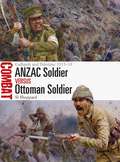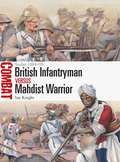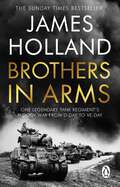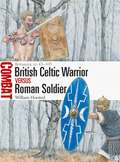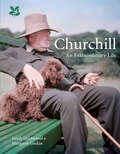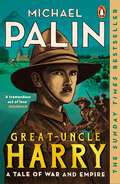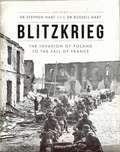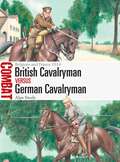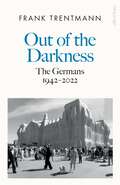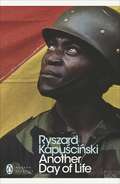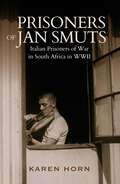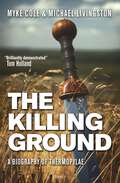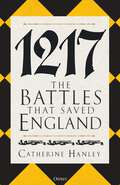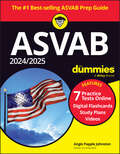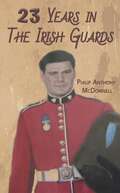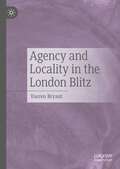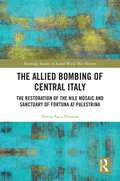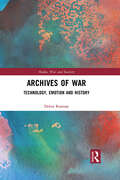- Table View
- List View
ANZAC Soldier vs Ottoman Soldier: Gallipoli and Palestine 1915–18 (Combat)
by Si SheppardIn 1915–18, ANZAC and Ottoman soldiers clashed on numerous battlefields, from Gallipoli to Jerusalem. This illustrated study investigates the two sides' fighting men.The Gallipoli campaign of 1915–16 pitched the Australian and New Zealand volunteers known as the ANZACs into a series of desperate battles with the Ottoman soldiers defending their homeland. In August 1915, the bitter struggle for the high ground known as Chunuk Bair saw the peak change hands as the Allies sought to overcome the stalemate that set in following the landings in April. The ANZACs also played a key part in the battle of Lone Pine, intended to divert Ottoman attention away from the bid to seize Chunuk Bair. The Gallipoli campaign ended in Allied evacuation in the opening days of 1916. Thereafter, many ANZAC units remained in the Middle East and played a decisive role in the Allies' hard-fought advance through Palestine that finally forced the Turks to the peace table. The fateful battle of Beersheba in October 1917 pitted Australian mounted infantry against Ottoman foot soldiers as the Allies moved on Jerusalem. In this book, noted military historian Si Sheppard examines the fighting men on both sides who fought at Lone Pine, Chunuk Bair and Beersheba. The authoritative text is supported by specially commissioned artwork and mapping plus carefully chosen archive photographs.
British Infantryman vs Mahdist Warrior: Sudan 1884–98 (Combat)
by Ian KnightIn the early 1880s, Britain intervened in independent Egypt and seized control of the Suez Canal. British forces were soon deployed to Egypt's southern colony, the Sudan, where they confronted a determined and capable foe amid some of the world's most inhospitable terrain. In 1881 an Islamic fundamentalist revolt had broken out in the Sudan, led by a religious teacher named Muhammad Ahmad bin Abd Allah, who proclaimed himself al-Mahdi, 'The Guided One'. In 1884, Mahdist forces besieged the Sudanese capital of Khartoum; Colonel Charles Gordon was sent to the city with orders to evacuate British personnel, but refused to leave. Although the British despatched a relief column to rescue Gordon, the Mahdists stormed Khartoum in January 1885 and he was killed. British troops abandoned much of the Sudan, but renewed their efforts to reconquer it in the late 1890s, in a bloody campaign that would decide the region's fate for generations. Written by leading expert Ian Knight, this fully illustrated study examines the evolving forces, weapons and tactics employed by both sides in the Sudan, notably at the battles of Abu Klea (16–18 January 1885), Tofrek (22 March 1885) and Atbara (8 April 1898).
Brothers in Arms: One Legendary Tank Regiment's Bloody War from D-Day to VE-Day
by James HollandFrom the bestselling author of Normandy '44 and Sicily '43, a brilliant new history of the last days of the war'Seldom is war so vividly described...An assault on the senses...Painful to read, impossible to put down' Gerard DeGroot, The TimesIt took a certain type of courage to serve in a tank in the Second World War. Encased in steel, surrounded by highly explosive shells, a big and slow-moving target, every crew member was utterly vulnerable to enemy attack from all sides. Living - and dying - in a tank was a brutal way to fight a war.The Sherwood Rangers were one of the great tank regiments. They had learned their trade the hard way, in the burning deserts of North Africa. From D-Day onwards, they were in the thick of the action til the war's end. They and their Sherman tanks covered thousands of miles and endured some of the fiercest fighting in Western Europe. Their engagements stretch from the Normandy beaches to the bridges at Eindhoven. They were the first British unit into Germany, grinding across the Siegfried Line and on into the Nazi heartland.Through compelling eye-witness testimony and James Holland's expert analysis, Brothers In Arms brings to vivid life the final bloody scramble across Europe and gives the most powerful account to date of what it was really like to fight in the dying days of World War Two.
British Celtic Warrior vs Roman Soldier: Britannia AD 43–105 (Combat)
by William HorstedAn illustrated study of the British tribal warriors and Roman auxiliaries who fought in three epic battles for control of Britain in the 1st century AD. Following the Roman invasion of Britain in AD 43, the tribes of the west and north resisted the establishment of a 'Roman peace', led in particular by the chieftain Caratacus. Even in the south-east, resentment of Roman occupation remained, exploding into the revolt of Boudicca's Iceni in AD 60. Roman auxiliaries from two particular peoples are known to have taken part in the invasion of Britain: the Tungrians, from what is now Belgium, and the Batavians, from the delta of the River Rhine in the modern Netherlands. From the late 80s AD, units of both the Batavians and the Tungrians were garrisoned at a fort at Vindolanda in northern Britain. The so called 'Vindolanda tablets' provide an unparalleled body of material with which to reconstruct the lives of these auxiliary soldiers in Britain.Featuring full-colour maps and specially commissioned battlescene and figure artwork plates, this book examines how both the British warriors and the Roman auxiliaries experienced the decades of conflict that followed the invasion. Their recruitment, training, leadership, motivation, culture and beliefs are compared alongside an assessment of three particular battles: the final defeat of Caratacus in the hills of Wales in AD 50; the Roman assault on the island of Mona (Anglesey) in AD 60; and the battle of Mons Graupius in Scotland in AD 83.
Churchill: An Extraordinary Life
by Sarah Gristwood Margaret Gaskin National Trust BooksA short illustrated life of one of Britain's most revered people of all time, covering all periods of his life but always returning to his literal and spiritual home, Chartwell.
Great-Uncle Harry: A Tale of War and Empire
by Michael Palin'An important historical record and a well-paced story in its own right, Great-Uncle Harry is also much more than that: a tremendous act of love.' Guardian___________________________________From the time, many years ago, when Michael Palin first heard that his grandfather had a brother, Harry, he was determined to find out more about him.The quest that followed involved hundreds of hours of painstaking detective work. Michael dug out every bit of family gossip and correspondence he could. He studied every relevant official document. He tracked down what remained of his great-uncle Harry's diaries and letters, and pored over photographs of First World War battle scenes to see whether Harry appeared in any of them. He walked the route Harry took on that fatal, final day of his life amid the mud of northern France. And as he did so, a life that had previously existed in the shadows was revealed to him.Great-Uncle Harry is an utterly compelling account of an ordinary man who led an extraordinary life. A blend of biography, history, travelogue and personal memoir this is Michael Palin at his very finest.___________________________________________PRAISE FOR EREBUS:'Beyond terrific. I didn't want it to end.' BILL BRYSON'Magisterial . . . Palin brings energy, wit and humanity to a story that has never ceased to tantalise people.' THE TIMES'Everybody's talking about it . . . A brilliant book.' CHRIS EVANS'I absolutely loved it: I had to read it at one sitting.' LORRAINE KELLY
Blitzkrieg: The Invasion of Poland to the Fall of France
by Stephen A. Hart Russell HartA fascinating study of the devastating new form of warfare that redrew the map of Europe in the opening year of World War II, bringing about the military collapse of three modern industrialized armies. On 1 September 1939, Nazi Germany launched the invasion of Poland, employing a new type of offensivewarfare: Blitzkrieg. So named by Allied observers because of the shock and rapidity of its effects, this newapproach was based on speed, manoeuvrability and concentration of firepower. The strategy saw startlingsuccess as the panzer divisions, supported by Stuka dive-bombers, spread terror and mayhem, reachingWarsaw in just one week. Aided by the intervention of the Soviet Union in the east, the campaign was overin a mere 36 days.This astonishing feat was followed by Operation Weserübung, the invasion of Denmark and then Norway in1940, the first joint air-sea-land campaign in the history of warfare. Even more striking an achievement wasthe swift and conclusive defeat of France during May–June 1940. Refusing to let its forces dash themselvesagainst the fortifications of the Maginot Line, Germany instead sent its divisions through neutral Belgiumand northern France in Fall Gelb ('Case Yellow'), destroying Allied resistance and pursuing the remnant ofthe British and French forces to Dunkirk in an audacious and devastatingly effective assault. During thecourse of Fall Rot ('Case Red') over the following 20 days, German forces pressed the attack and by 25 Junehad forced France's leaders into a humiliating capitulation.Illustrated throughout with detailed maps, artwork and contemporary photographs, Blitzkrieg: TheInvasion of Poland to the Fall of France tells the story of these first breakneck attacks, examining the armedforces, leaders, technology, planning and execution in each campaign as well as the challenges faced by theGermans in the pursuit of this new and deadly form of warfare.
British Cavalryman vs German Cavalryman: Belgium and France 1914 (Combat)
by Alan SteeleFully illustrated, this book casts light on the utility and role of the German and British cavalry in the early stages of World War I on the Western Front.In the early months of World War I, before the fighting degenerated into static trench warfare, there was a brief period of mobile combat as the German Army advanced through Belgium and northern France, forcing the French and British forces facing them to retreat. Both sides in the escalating conflict deployed substantial numbers of cavalry units to screen their infantry forces, conduct reconnaissance and harness their superior mobility to undertake aggressive combat operations. In the summer of 1914, the British cavalry had the difficult task of covering the withdrawal of the British Expeditionary Force and the German cavalry, the equally demanding task, after weeks of combat and forced marches, of maintaining contact with a rapidly retiring enemy.In this book a comparative assessment is made of each side's doctrine, organization, equipment and training, followed by a detailed analysis of their actual performance in three key encounter actions: Casteau/Soignies (22 August), Cérizy/Moÿ (28 August) and Le Montcel/Frétoy (7 September). This analysis is supported by carefully chosen photographs and specially commissioned full-colour artwork and maps.
Out of the Darkness: The Germans, 1942-2022
by Frank TrentmannA groundbreaking new history of the people at the centre of Europe, from the Second World War to todayIn 1945, Germany lay in ruins, morally and materially. The German people stood condemned by history, responsible for a horrifying genocide and a war of extermination. But by 2015 Germany looked to many to be the moral voice of Europe, welcoming almost one million refugees. At the same time, it pursued a controversially rigid fiscal discipline and made energy deals with a dictator. Many people have asked how Germany descended into the darkness of the Nazis, but this book asks another vital question: how, and how far, have the Germans since reinvented themselves?Trentmann tells the dramatic story of the Germans from the middle of the Second World War, through the Cold War and the division into East and West, to the fall of the Berlin Wall and the reunited nation's search for a place in the world. Their journey is marked by extraordinary moral struggles: guilt, shame and limited amends; wealth versus welfare; tolerance versus racism; compassion and complicity. Through a range of voices - German soldiers and German Jews; environmentalists and coal miners; families and churches; volunteers, migrants and populists - Trentmann paints a remarkable and surprising portrait over 80 years of the conflicted people at the centre of Europe.
Another Day of Life (Forsyte chronicles)
by Ryszard Kapuscinski William Brand'This is a very personal book, about being alone and lost'. In 1975 Kapuscinski's employers sent him to Angola to cover the civil war that had broken out after independence. For months he watched as Luanda and then the rest of the country collapsed into a civil war that was in the author's words 'sloppy, dogged and cruel'. In his account, Kapuscinski demonstrates an extraordinary capacity to describe and to explain the individual meaning of grand political abstractions.
Routledge Handbook of NATO
by John Andreas OlsenThis handbook provides a comprehensive survey of the development and importance of the North Atlantic Treaty Organisation (NATO), its role in international relations and its influence on history.The volume examines the Alliance’s evolution in breadth, depth and context by analysing and explaining why and how NATO has endured and remained relevant since its creation. To present an inclusive study of the Alliance’s activities and milestone events and to offer a glimpse of future challenges, the book’s 29 chapters fall into six thematic sections that act as frameworks and allow the exploration of specific topics that pertain to the evolution of NATO: Part I: History of NATO, 1949–2024 Part II: Key Enduring Themes, 1949–2024 Part III: Military Operations, 1995–2024 Part IV: National Perspectives, 1949–2024 Part V: Regional Perspectives, 1949–2024 Part VI: Future Prospects, 2024– This handbook will be of much interest to students and researchers of NATO, strategic studies, defence studies and International Relations, as well as for staff and fellows at security- and defence-oriented think tanks and government officials, military personnel and other practitioners in the areas of foreign affairs and defence.
Routledge Handbook of NATO
This handbook provides a comprehensive survey of the development and importance of the North Atlantic Treaty Organisation (NATO), its role in international relations and its influence on history.The volume examines the Alliance’s evolution in breadth, depth and context by analysing and explaining why and how NATO has endured and remained relevant since its creation. To present an inclusive study of the Alliance’s activities and milestone events and to offer a glimpse of future challenges, the book’s 29 chapters fall into six thematic sections that act as frameworks and allow the exploration of specific topics that pertain to the evolution of NATO: Part I: History of NATO, 1949–2024 Part II: Key Enduring Themes, 1949–2024 Part III: Military Operations, 1995–2024 Part IV: National Perspectives, 1949–2024 Part V: Regional Perspectives, 1949–2024 Part VI: Future Prospects, 2024– This handbook will be of much interest to students and researchers of NATO, strategic studies, defence studies and International Relations, as well as for staff and fellows at security- and defence-oriented think tanks and government officials, military personnel and other practitioners in the areas of foreign affairs and defence.
Prisoners of Jan Smuts: Italian Prisoners of War in South Africa in WWII
by Karen HornEqually skilled in a variety of trades other than in the art of love, the Italian prisoners of war (POWs) who were incarcerated in South Africa during the Second World War are a source of great fascination to this day. Who were these men? And what made some of them attempt dramatic escapes, while others wanted to stay behind after the war? The first Italian POWs arrived in the Union of South Africa in early 1941, most of them being held in Zonderwater Camp outside Cullinan or in work camps across the country. The government of Jan Smuts saw them as a source of cheap labour that would contribute to harvesting schemes, road-building projects such as the old Du Toit's Kloof Pass between Paarl and Worcester and even to prickly-pear eradication schemes. Prisoners of Jan Smuts recounts the stories of survival and shenanigans of the Italian POWs in the Union through the eyes of five prisoners who had documented their experiences in memoirs and letters. While many POWs seemed to appreciate the opportunities to gain new skills, others clung to the Fascist ideas they had grown up with and refused to work. Many opted to remain in South Africa once the war had ended, forging quite a legacy. These included sculptor Edoardo Villa, who left an important mark in the local and international art world, and businessman Aurelio Gatti, who built an ice-cream empire whose gelato was to delight generations of South Africans.
The Killing Ground: A Biography of Thermopylae
by Myke Cole Dr Michael LivingstonAn exploration into why and how Thermopylae is one of the most blood-soaked patches of ground in history – and what its past can tell us about our future.'Brilliantly demonstrated.' - Tom HollandSince the dawn of the Classical Era up to World War II, thousands have lost their lives fighting over the pass at Thermopylae. Historians Cole and Livingston provide an exciting account of each of the 27 battles and holding actions that took place. The epic events of 480 BC when 300 Spartans attempted to hold the pass has been immortalised in poetry, art, literature and film. But no history has ever detailed the other events from the very first battle through to the battles fought by Romans, Byzantines, Huns and Ottomans during the early and late medieval periods and finally the two desperate struggles against German occupying forces during World War II. The Killing Ground details the background and history of each conflict, the personalities and decision making of the commanders, the arms and tactics of the troops, and how each battle played out. Cole and Livingston have surveyed the ground to provide a boots-on understanding of each battle. Their command of multiple ancient and medieval languages means they have provided their own translations of much of the source material, ensuring new insights into each battle. This uncompromising scholarship is woven together into a compelling and unforgettable history that grips the reader from start to finish.
1217: The Battles that Saved England
by Dr Catherine HanleyAn engrossing history of the pivotal year 1217 when invading French forces were defeated and the future of England secured. In 1215 King John had agreed to the terms of Magna Carta, but he then reneged on his word, plunging the kingdom into war. The rebellious barons offered the throne to the French prince Louis and set off the chain of events that almost changed the course of English history. Louis first arrived in May 1216, was proclaimed king in the heart of London, and by the autumn had around half of England under his control. However, the choice of a French prince had enormous repercussions: now not merely an internal rebellion, but a war in which the defenders were battling to prevent a foreign takeover. John's death in October 1216 left the throne in the hands of his nine-year-old son, Henry, and his regent, William Marshal, which changed the face of the war again, for now the king trying to fight off an invader was not a hated tyrant but an innocent child.1217 charts the nascent sense of national identity that began to swell. Three key battles would determine England's destiny. The fortress of Dover was besieged, the city of Lincoln was attacked, and a great invasion force set sail and, unusually for the time, was intercepted at sea. Catherine Hanley expertly navigates medieval siege warfare, royal politics, and fighting at sea to bring this remarkable period of English history to life.
2024/2025 ASVAB For Dummies: Book + 7 Practice Tests + Flashcards + Videos Online
by Angie Papple JohnstonGet the score you need to get the job you want! The bestselling ASVAB For Dummies is back with an updated and expanded annual edition. This trusted study guide will help you succeed on the essential military recruitment test. Now with more examples, walk-throughs, and practice questions, you can land the score that will qualify you for your preferred military job. With practice tests in the book and online, videos, and hundreds of digital flashcards, this Dummies resource is perfect for all things ASVAB. Trusted by military recruiters across the country, this book also includes insider tips and tricks for test-day-success. Study at your own pace and make your dreams possible with ASVAB For Dummies. Learn from simple explanations of all the content covered on the ASVAB, plus tons of resources for studying Follow detailed study plans that will help you prepare 12 weeks, 6 weeks, 4 weeks, or 1 week before the test Take practice tests and work through detailed answer explanations to improve your score Get even more practice online, with practice tests, flashcards, and videos For years, ASVAB For Dummies has been helping recruits launch their military careers right. Now, it's your turn.
2024/2025 ASVAB For Dummies (+ 7 Practice Tests, Flashcards, & Videos Online)
by Angie Papple JohnstonGet the score you need to get the job you want! The bestselling ASVAB For Dummies is back with an updated and expanded annual edition. This trusted study guide will help you succeed on the essential military recruitment test. Now with more examples, walk-throughs, and practice questions, you can land the score that will qualify you for your preferred military job. With practice tests in the book and online, videos, and hundreds of digital flashcards, this Dummies resource is perfect for all things ASVAB. Trusted by military recruiters across the country, this book also includes insider tips and tricks for test-day-success. Study at your own pace and make your dreams possible with ASVAB For Dummies. Learn from simple explanations of all the content covered on the ASVAB, plus tons of resources for studying Follow detailed study plans that will help you prepare 12 weeks, 6 weeks, 4 weeks, or 1 week before the test Take practice tests and work through detailed answer explanations to improve your score Get even more practice online, with practice tests, flashcards, and videos For years, ASVAB For Dummies has been helping recruits launch their military careers right. Now, it's your turn.
23 Years in The Irish Guards
by Philip Anthony McDonnellHaving signed on the dotted line to be an Irish guardsman not fully understanding all that Queen and country, and other territories stuff, that after six weeks on my own help only by others, I slept beside in the gutter since leaving Ireland to see the world. Finding no work, food and shelter I was on my knees and making this last day as a homeless orphan in Liverpool to ask at the port about working my passage home to Dublin when I saw a window display asking for men to join the Irish guards that foxed my mind as to who or what Irish guards are. It was recruiter Sgt George Smylie Liverpool office kind offer of a cup of tea and biscuit and warm manner that close the deal making my dream to see the world happen.
Agency and Locality in the London Blitz
by Darren BryantThis book takes a fresh approach to the London Blitz by viewing this time through individual local boroughs of the metropolis. The term ‘London Blitz’ means that culturally we have become accustomed to understanding that the actual blitz experience was the same wherever in the capital one happened to be, despite some areas being hit more than others. This book illustrates how there were many London blitzes, not one, influenced by a myriad of metropolitan localities, and giving rise to an agency of locality that helped to shape the lived blitz experience. By walking through the streets of London, this book conducts a local area analysis, witnessing the blitz through six London localities, representative of the assorted administrative, economic, and socio-political variables prevalent in wartime London. Covering air raids alongside topics like the provision of shelters, homelessness, and communal feeding, it shows how any history of the London Blitz must acknowledge that it was an experience reflective of a varied metropolis.
The Allied Bombing of Central Italy: The Restoration of the Nile Mosaic and Sanctuary of Fortuna at Palestrina (Routledge Studies in Second World War History)
by Teresa Fava ThomasThe Allied Bombing of Central Italy examines the results of the Second World War Allied bombing campaign on Palestrina and Rome, Italy, and the long-term impact of the war on the mountainside town and on the Barberini family's art collection including the Nile Mosaic. It explores the history and cultural significance of Palestrina, its strategic setting, the recovery of the town, the restoration of the Nile Mosaic, which remains the largest Egyptian-style mosaic extant. A unique aspect of the destruction was that it uncovered a pagan temple, the Sanctuary of Fortuna. The bombing destroyed the homes built on its terraces but revealed the ancient structure buried beneath which had remained unseen for half a millennium. It took more than a decade for the mosaic to be restored and the Sanctuary of Fortuna established as a national archeological museum. The book explores the pressure by the Mussolini regime to control the Barberini family's art collection, the uses of cultural materials for propaganda purposes, the Allied use of airpower in the Italian theater of war, the postwar decision-making and recovery process. The book is one of the very few long-range studies of the war's impact on a single Italian town. It is suitable for academic seminars and an educated general audience.
The Allied Bombing of Central Italy: The Restoration of the Nile Mosaic and Sanctuary of Fortuna at Palestrina (Routledge Studies in Second World War History)
by Teresa Fava ThomasThe Allied Bombing of Central Italy examines the results of the Second World War Allied bombing campaign on Palestrina and Rome, Italy, and the long-term impact of the war on the mountainside town and on the Barberini family's art collection including the Nile Mosaic. It explores the history and cultural significance of Palestrina, its strategic setting, the recovery of the town, the restoration of the Nile Mosaic, which remains the largest Egyptian-style mosaic extant. A unique aspect of the destruction was that it uncovered a pagan temple, the Sanctuary of Fortuna. The bombing destroyed the homes built on its terraces but revealed the ancient structure buried beneath which had remained unseen for half a millennium. It took more than a decade for the mosaic to be restored and the Sanctuary of Fortuna established as a national archeological museum. The book explores the pressure by the Mussolini regime to control the Barberini family's art collection, the uses of cultural materials for propaganda purposes, the Allied use of airpower in the Italian theater of war, the postwar decision-making and recovery process. The book is one of the very few long-range studies of the war's impact on a single Italian town. It is suitable for academic seminars and an educated general audience.
Alvesdon
by James Holland'A beautiful, evocative novel that captures the fear and mood of the early days of the war' Dylan O'LearyThe village of Alvesdon has been home to the Castells for generations. But the year is 1939 and the peace and tranquillity there is about to be shattered once more by the stormclouds of war in Europe. As three generations of the family gather, they must all face the prospect of their lives being transformed beyond recognition the moment Britain declares war on Germany.When the inevitable happens and Britain finds itself at war, the younger members of the family and farm workers are called up to fight and those who remain must battle to keep the home fires burning and the farm afloat. The gentle certainties of rural life are replaced by the urgent clamour of war, in the air, at sea and on land, where events unfold with dizzying rapidity and unexpected consequences.Stretching from the glorious summer of 1939 to the Battle of Britain the following year, acclaimed historian James Holland paints a compelling and immersive fictional portrait of how the war changed everything. For one family and for a community, their way of life can never really be the same again…
Archives of War: Technology, Emotion and History (Media, War and Security)
by Debra RamsayThis book offers a comparative analysis of British Army Unit War Diaries in the two World Wars, to reveal the role played by previously unnoticed technologies in shaping the archival records of war. Despite thriving scholarship on the history of war, the history of Operational Record Keeping in the British Army remains unexplored. Since World War I, the British Army has maintained daily records of its operations. These records, Unit War Diaries, are the first official draft of events on the battlefield. They are vital for the army’s operational effectiveness and fundamental to the histories of British conflict, yet the material history of their own production and development has been widely ignored. This book is the first to consider Unit War Diaries as mediated, material artefacts with their own history. Through a unique comparative analysis of the Unit War Diaries of the First and Second World Wars, this book uncovers the mediated processes involved in the practice of operational reporting and reveals how hidden technologies and ideologies have shaped the official record of warfare. Tracking the records into The National Archives in Kew, where they are now held, the book interrogates how they are re-presented and re-interpreted through the archive. It investigates how the individuals, institutions and technologies involved in the production and uses of unit diaries from battlefield to archive have influenced how modern war is understood and, more importantly, waged. This book will be of much interest to students of media and communication studies, military history, archive studies and British history.
Archives of War: Technology, Emotion and History (Media, War and Security)
by Debra RamsayThis book offers a comparative analysis of British Army Unit War Diaries in the two World Wars, to reveal the role played by previously unnoticed technologies in shaping the archival records of war. Despite thriving scholarship on the history of war, the history of Operational Record Keeping in the British Army remains unexplored. Since World War I, the British Army has maintained daily records of its operations. These records, Unit War Diaries, are the first official draft of events on the battlefield. They are vital for the army’s operational effectiveness and fundamental to the histories of British conflict, yet the material history of their own production and development has been widely ignored. This book is the first to consider Unit War Diaries as mediated, material artefacts with their own history. Through a unique comparative analysis of the Unit War Diaries of the First and Second World Wars, this book uncovers the mediated processes involved in the practice of operational reporting and reveals how hidden technologies and ideologies have shaped the official record of warfare. Tracking the records into The National Archives in Kew, where they are now held, the book interrogates how they are re-presented and re-interpreted through the archive. It investigates how the individuals, institutions and technologies involved in the production and uses of unit diaries from battlefield to archive have influenced how modern war is understood and, more importantly, waged. This book will be of much interest to students of media and communication studies, military history, archive studies and British history.
Armed Organizations and Political Elites in Civil Wars: Pathways to Power in Syria and Iraq (Routledge Studies in Civil Wars and Intra-State Conflict)
by Erwin van VeenThis book analyses under what conditions, and with what developmental effects, armed organizations shift their ‘coercive profile’ during civil wars, with a focus on the recent conflicts in Syria and Iraq.The work begins with an operationalisation of the term ‘political settlement’, focusing on how power is organized in fragile and conflict-affected countries, and then uses this operationalization to analyse the political settlements of contemporary Syria and Iraq, including their breakdown and transformation during recent civil wars (of 2011-today in Syria and 2014-17 in Iraq). It subsequently examines why and how elite factions have used armed organizations in times of conflict. This approach links an understanding of the broad evolution of power relations at the national level with the specific effects of the use of armed organizations on such relations. It argues for a shift from assigning fixed labels to armed organizations during civil wars to studying their coercive profile in a dynamic fashion, i.e. how armed organizations behave in terms of their use of threats and coercive force. The book introduces five profiles of coercive behaviour that demonstrate how the same organization can behave very differently at various points in time. One of these, the ‘hybrid coercive profile’, fills a gap in the existing civil war typology of organized armed violence by opening up the possibility of elite factions deliberately combining collaborative and competitive modes of behaviour. As an evidence base, the book provides in-depth analysis of the origins, evolution and operations of four armed organizations that have acted under a hybrid coercive profile during the Syrian and Iraqi civil wars: the Syrian Kurdish People’s Defence Forces, the Eagles of the Whirlwind of the Syrian Social Nationalist Party, the Iraqi Kurdish Peshmerga and the Badr Organization. By connecting the concepts of political settlement and civil war, and applying them to specific armed organizations operating in Syria and Iraq, the book offers new insights into this nexus.This book will be of much interest to students of civil wars, conflict studies, Middle Eastern Studies and International Relations.
